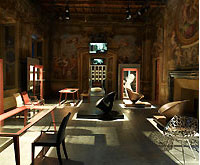 Just before Design Week and Salone del Mobile kicked off here in Milan, we had the chance to meet Elisa Astori, the Managing Director of Driade. Driade began in the late 60's by producing finished pieces of furniture, and now designs and produces furniture, kitchens, objects and complements for total living systems. With 45 internal designers, and frequent external collaborations, Driade's focus is on exploring aesthetics to provide an ecclectic living experience.
Design collaborations first began in Japan in 1989, as the company began to search for creativity, design critiques, cultural personalities, and so on with the intention of bringing emotion to clients through their environment, and to anticipate and precede trends. The Japanese contact was made by chance through a need to resolve highly technical production issues. Next retail partnerships were formed for distribution, and then the Japanese architect Toyo Ito was introduced to the company designers. Through this collaboration, Ito embarked on a new scale of design, and Driade's new design aesthetic evolved. The strong Japanese aesthetic within Driade set the rythm for ecclectic and multicultural design inspiration, and the company next collaborated with designers from China, using traditional materials in new ways. This year, the company began it's collaboration work with designers from India.
Just before Design Week and Salone del Mobile kicked off here in Milan, we had the chance to meet Elisa Astori, the Managing Director of Driade. Driade began in the late 60's by producing finished pieces of furniture, and now designs and produces furniture, kitchens, objects and complements for total living systems. With 45 internal designers, and frequent external collaborations, Driade's focus is on exploring aesthetics to provide an ecclectic living experience.
Design collaborations first began in Japan in 1989, as the company began to search for creativity, design critiques, cultural personalities, and so on with the intention of bringing emotion to clients through their environment, and to anticipate and precede trends. The Japanese contact was made by chance through a need to resolve highly technical production issues. Next retail partnerships were formed for distribution, and then the Japanese architect Toyo Ito was introduced to the company designers. Through this collaboration, Ito embarked on a new scale of design, and Driade's new design aesthetic evolved. The strong Japanese aesthetic within Driade set the rythm for ecclectic and multicultural design inspiration, and the company next collaborated with designers from China, using traditional materials in new ways. This year, the company began it's collaboration work with designers from India.
Distribution currently exists in 84 countries predominantly in Europe. The company is pushing for new growth in emerging countries, especially through these strategic design collaborations. By always working between high design and industrialized materials (such as plastic), the company balances a high-low dimension, and introduces many smaller household elements handcrafted around the world in various native materials as complementors.
The company is interior design-based, with experts in many materials, thus taking the company from a product-focused strategy to a total corporate identity. The business model is therefore design-based, with production outsourced to various specialized manufacturers, and the majority of resources and attention centered on the design process and results. The outsourced manufacturers are now increasingly located in Eastern Europe or the Far East, and as the design teams are increasingly international, what is left of the "Made in Italy" business model is the design culture of the brand and the company.
According to Astori, the world is rapidly changing, and there is no emerging generation of Italian craftsmen, as many young Italians are encouraged to pursue a professional degree and often wish to leave the country upon graduation. Driade's current prototypist is now 70 years old, and while several students have taken a very short internship with him from design school, there is no apprentice program in place, no placement system, and apparently no interested applicants (if there were interested applicants, they would have a hard time making their interest known, however). Therefore, there is no one to invest in for local training in the traditional craft of Italian furniture production, and if Driade were to depend on the craftsmen of Italy for design and production it would be bankrupt in 5 years when the craftsmen stop producing.